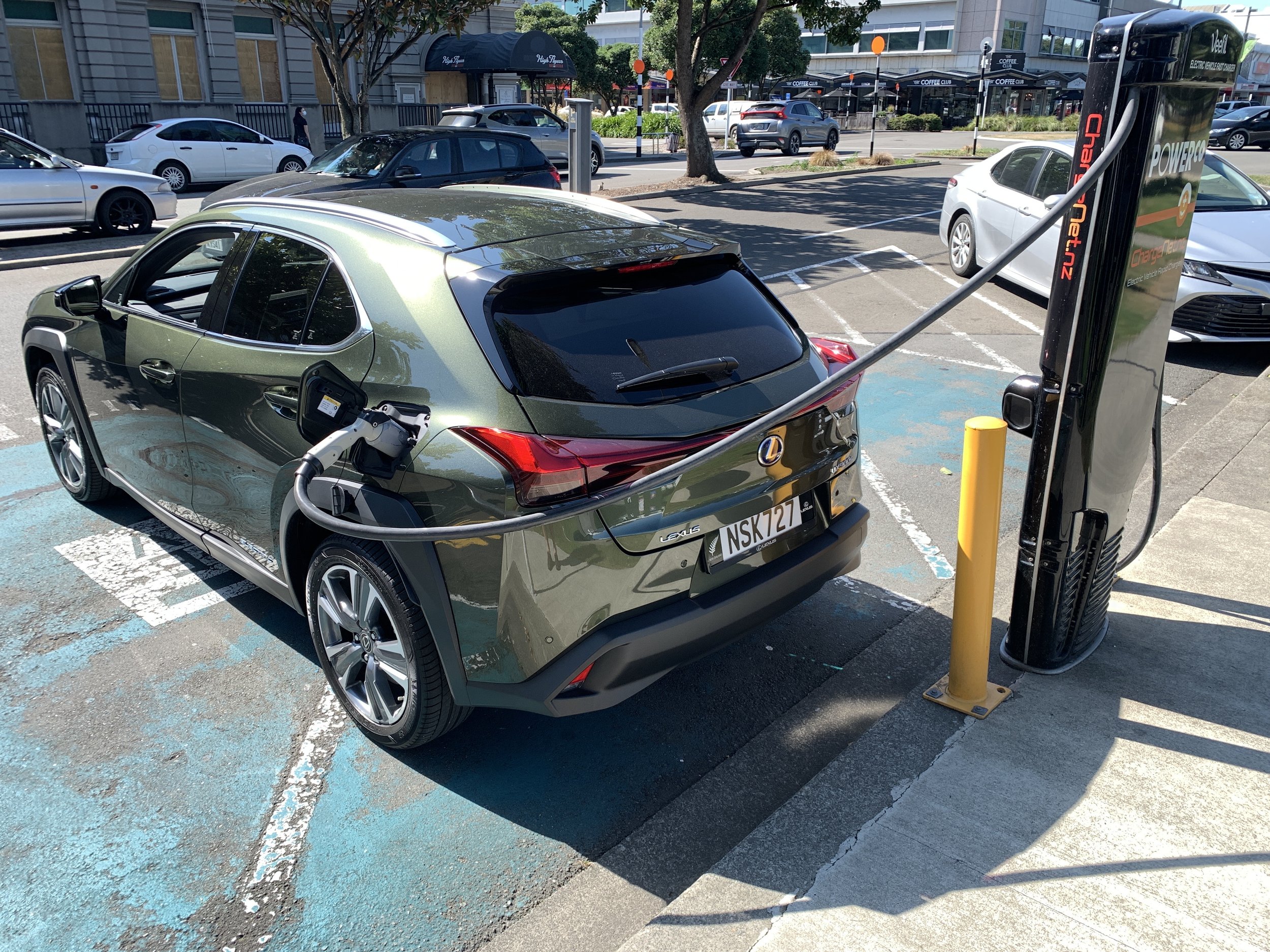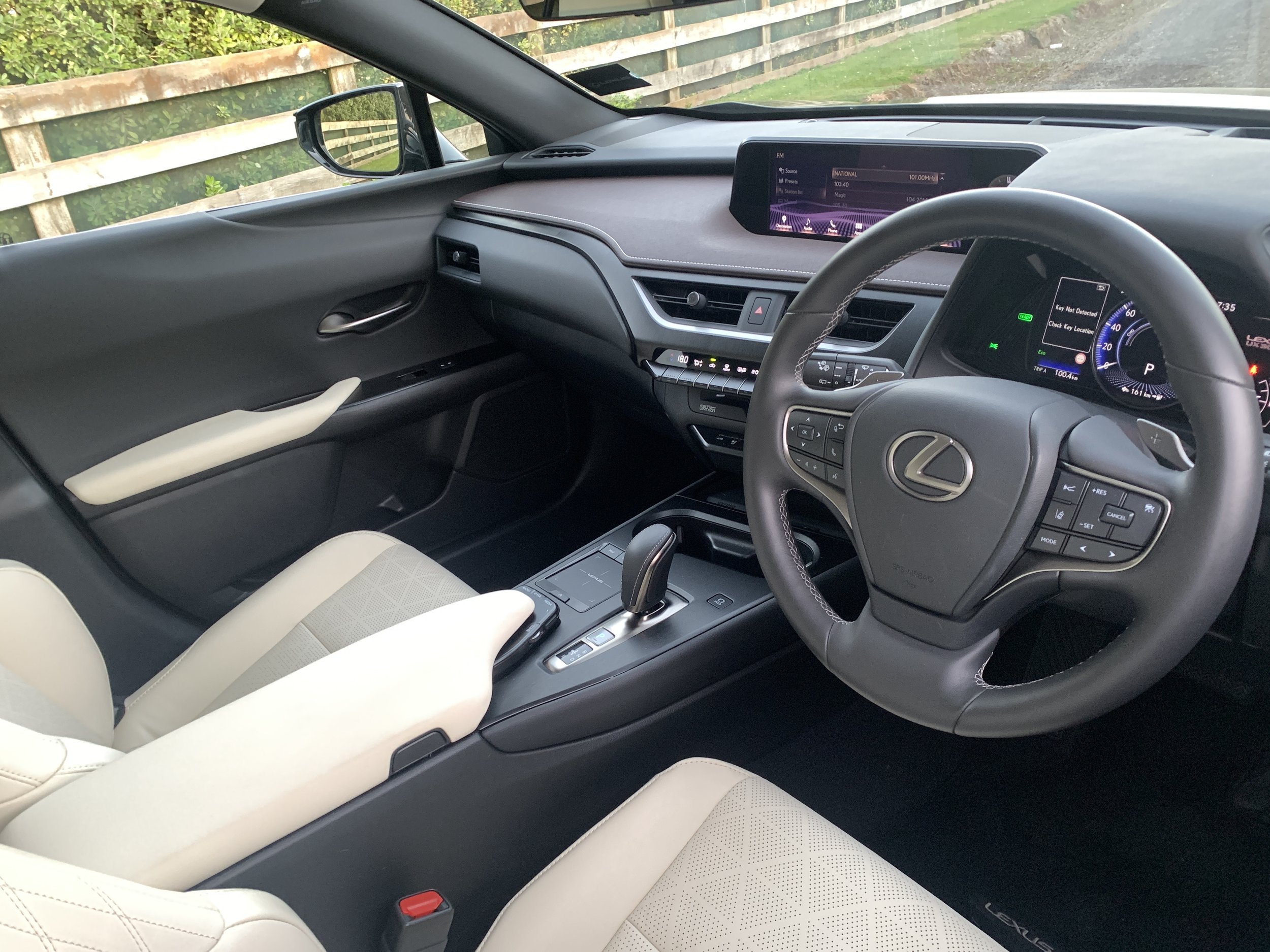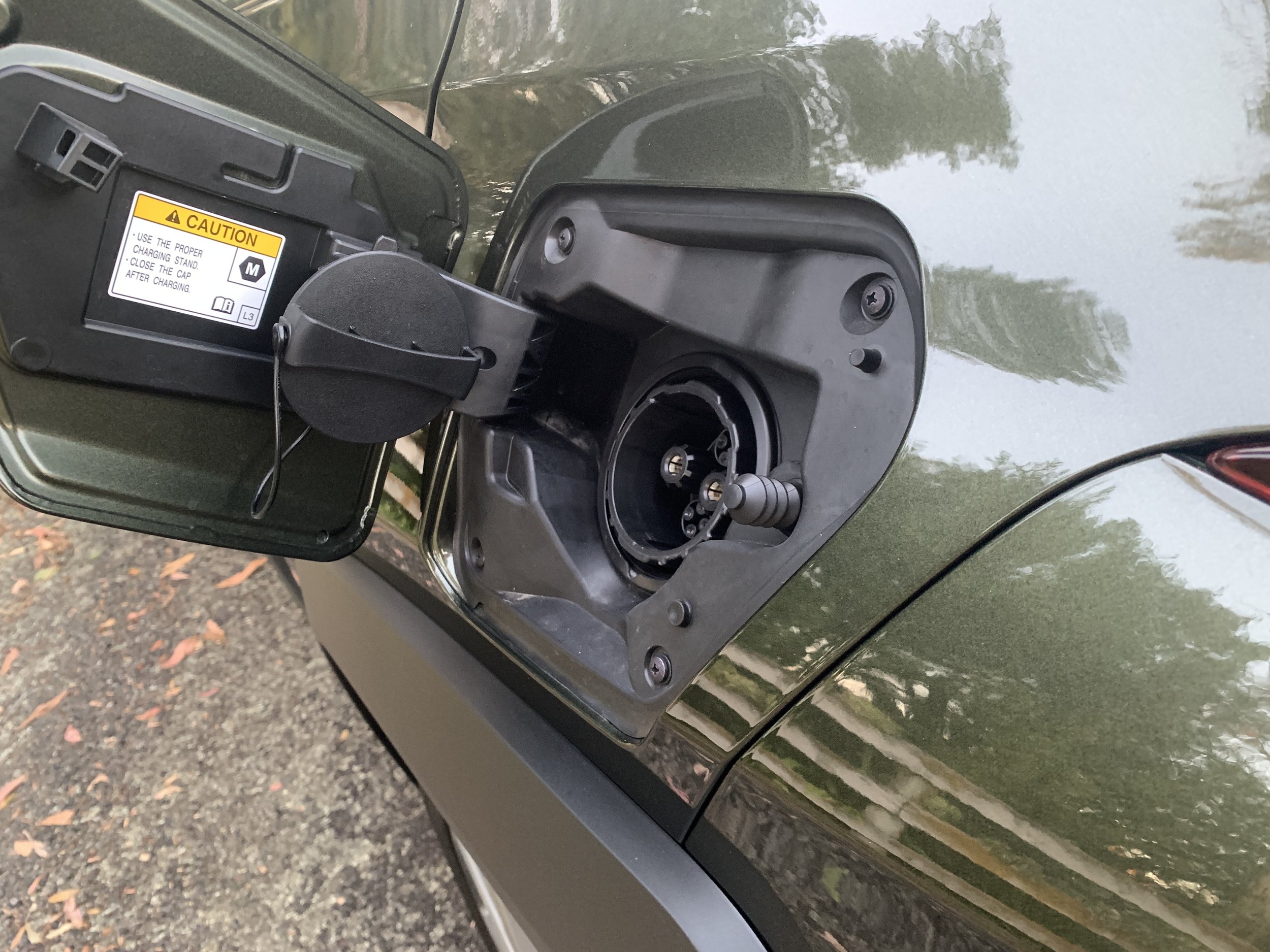Lexus UX300e road test review: Quality with quirks
/It’s great to see the brand join the electric car sector, but it’s a shame the debut car isn’t up to full pace with its charging technology.
Price: $79,990 (eligible for $8625 rebate)
Powertrain and economy: single electric motor 54.3 lithium-ion battery, 150kW/ 300Nm, two-speed automatic, FWD, claimed combined economy 15.0kWh/100km.
Vital statistics: 4495mm long, 1545mm high, 1840mm wide, 2620mm wheelbase, 303 litres luggage capacity, 18-inch wheels.
Like: Superb build quality, refinement, driving feel.
Don't like: Dated charging set-up, restricted range, touch pad.
ENGLISH, geography, history … a breeze. Languges? J’ai bien fait/ Mir ging is gut. Science was a struggle. Maths? Don’t go there.
With that track record, I was the recipient of some interesting report cards during my time at school. A broad spread of teacher comment; everything from wholesale praise to being labelled a “castaway on the ship of life.”
The overall summary for first all-electric car Lexus is offering New Zealand, the UX300e, is akin to what I tended to hear. Lots of ‘plenty of promise’, ‘needs to try harder’, ‘could/must do better’.
On the plus side, it’s a well-presented and sensibly-priced complement to the existing hybrid UX range. A sticker that has it sit but $10 short of the cut-off for a Clean Car rebate might seem cheeky, but it’s a premium product and with that slim margin being quite enough to ensure to secure a fat $8625 Clean Car cheque, where’s the harm?
On that note, even if questions raise in respect to some technology approaches the standard of fit, finish and presentation is surely beyond reproach.
As much as I find it hard to agree with the concept of craftsmanship occurring on mass-produced products, in this instance the quality - from paintwork and panel gaps to the interior materials - is so undeniably superb you cannot help but think it’s been subject to above-average expertise.
Lovely Lexus-ness occurs with the ride quality, too. Electric cars invariably have advantage here; batteries are heavy items and with the cells housed in the floor the centre-of-gravity is low, but there’s also a settling effect on the suspension. If you like a quiet and easy drive, this is a good pathway.
Lexus says its design path for all its EVs will avoid the outragerous; it wants those cars to look normal. Reality is that the UX appears like a normal UX – save for having plug-in ports on each front flank, the word 'Electric' on the lower portion of the rear doors, a more aerodynamic front grille, special 'aero-ventilating' alloy wheels – because it’s based on a regular UX. I don’t see that as an issue, because the donor is a smart-looking, but those out to be loud in their pride might have a different view. tIn the cabin, too, there’s a lot of familiarity, not least for anyone slipping across the hybrid, as it has the same eco, normal and sport modes.
Running batteries frees up a bit more usable cabin space as well, but it’s a compact class car, so a cosy cabin comes with that territory. Rear seat space is adequate, but limited legroom is unavoidable. Small windows also mean it feels rather claustrophobic back there. Modest luggage capacity is a UX bugbear, and though the electric, with 310 litres, outdoes the hybrid electric (a mediocre 268), this is not a class leader.
Judging the UX300e on its premium qualities delivers good scores; but is that enough to ‘sell’ it to the EV crowd? Honestly, it’s hard to say.
However you consider it, this is a product with its work cut out when it comes to convincing it is top level contender in pure electric operability; it’s hampered by relatively short range while a 0-100kmh of 7.5 seconds and a top speed of 160kmh are okay, it won’t be grabbing any headlines.
Those factors are not outright ruinous, but the car’s usefulness really comes down to how well it suits your daily driving regime.
If that’s primarily just about short trips, mainly at urban speeds – which all research suggests is a common regime and which surely also suits the UX’s whole chic city-centric persona - then sure, it’ll be a breeze to keep.
However, the UX300e almost conspires to make you want to adventure far further, because it has a reasonably decent open road demeanour; not of the same calibre as a Hyundai Ioniq 5 or a Polestar, but not too bad given its DNA.
Even though it is not an overtly sporty car in performance and handling aspect - it’s hauling another 185kg over the hybrid and the fashion for raised ride height also taints the dynamics – it’s not hopeless. Yes, there are more potent EVs to buy into for this price but the drivetrain feels stronger and more reactive than on-paper stats would suggest. There’s enough torque to that you need quell throttle play on damp, greasy surfaces else it’ll beat its own traction control and momentarily spin the front wheels.
Handling-wise it errs more toward comfort than cornering charisma, the body control feels a touch looser and less constrained than I recall the other models being, but the centre of gravity being very low makes it feel secure and also is a plus factor for a cosseting ride and the superb refinement.
The bugbear of all EVs is that, with no engine noise, it’s actually more challenging to hide other sounds, like wind or tyre roar at speed. Masses of sound-deadening around the cabin do the trick here. It’s a truly quiet car. I took it on a four-hour out of town run and it drove nicely, overall.
However, that escapade reinforced that, in situations where absolute range has an unavoidable influence, then it’s a car in which you need to plan ahead and prudently, because it’ll almost certainly require replenishment somewhere along the way.
This exercise reinforced why the NEDC test figure of 360km that Lexus NZ cites as possible from the 54kWh battery-fed single motor drivetrain should simply be ignored. Though still officially valid, NEDC values are well and truly discredited and the one the brand cites is downright facetious. From this experience, the usually more valid WLTP count, which in this instance suggests 300-315km, is also hugely optimistic.
The car was charged four times during a seven-day test; twice on a 50kWh ChargeNet charger with fastest-choice direct current; twice at home on alternating current trickle charge. The optimal range I saw on the trip computer from a careful 100 percent replenishment was 267km. You can hear the Tesla Model 3 and Hyundai Ioniq 5 fan clubs sniggering now.
Real-world consumption? It’s one of those EVs that seems particularly susceptible to losing range (around 20km by my feel) with the AC operating (often the case with me). The Eco/Normal/Sport drive modes also make quite a difference. Normal is the default and sensibly so. Eco mode is truly that; the problem is that car just feels sluggish in it. Sport genuinely makes it much perkier, yet you’ll pay for it.
Anyway, the old saw about taking every opportunity to replenish the battery seems to be a good approach. On that side (little ‘in’ joke there) of things, the UX300e is unusual in that it has two ports; one each for AC and DC, but all the moreso with the latter being an older-style Chademo plug. There are plenty of CHAdeMO rapid chargers around it can plug into but almost every new EV on sale uses a different socket type, called CCS. That’s the standard all new rapid chargers are compatible with. As the infrastructure grows, CCS promises to be more convenient. As far as I know, the only other products coming here with Chademo are ex-Japan used imports.
Those are quirks you might cope with easier than the flow rate for ‘rapid’ recharging being capped at 50kWh. If you hook up to a truly fast charger, that’s like turning up to a petrol station and feeding in fuel through a garden hose. Replenishment to 80 percent takes almost an hour. Taking it to 100 percent requires 80 minutes. That puts it in the same league as large battery models that are built for 300kWh charging but have to make do with 50kWh. Enjoys your coffees. Bring a book.
I used two 50kWh charging stations. The first visit started well, but ended badly. I plugged the car in at the town square, went for a short walk, to come back to find it had been unplugged. The person responsible was the driver of a Nissan Leaf who claimed the Lexus had finished its session so he’d taken over the plug. How he did that I’m still confused by; when the Lexus is locked (as it was), the charger tether should be as well. Anyway, long story short, the UX appeared undamaged and the guy was fibbing … the car was only up to 73 percent charged, from 67 percent when I began.
On the second occasion, the battery replenished to 90 percent without incident but wouldn’t uncouple when I halted the feed. Was it the unit (they’re not infallible). Was it the car? Separation anxiety ended with charger being emergency-stopped.
The AC option ran seamlessly but, of course, you need to give it time - lots of time (six hours with a wallbox, 24 on a wall plug) as the replenishment rate is more modest than many, at just 6.6kWh (11kWh is normal). Not necessarily a car for super-busy lifestyles, then.
In being slow to take on electricity, it’s also reluctant to impart with huge accuracy about how it’s consuming it; another weirdness if you used to Lexus and Toyota hybrids – if anything, those go overboard on that side of things. Yet though the instrumentation includes some electric-specific functions, the primary distance to empty guidance is orthodox fuel gauge ( that, instead of the usual fuel-pump logo, has a motif of a little plug on the end of the cable) and there’s not a lot else in the sub-menus to deliver much more accuracy.
Another tie to the brand’s hybrid products is the 'B' setting on the shift lever, to deliver regenerative braking. Using the paddles on the wheel like an automatic gearbox is another option, shifting ‘down’ with the left one when slowing to help charge the battery instead of slowing with the brakes. Either effect isn’t anything like as strong as in some electric cars (or, for that matter, a Lexus hybrid) and you can’t drive the UX300e on one pedal. When leaving B setting, too, you have to take car not to inadvertently slip the car into neutral.
In terms of comforts and safety, it hits closer to a bulls-eye. Front and rear seat heaters and front seat ventilation, a complex air conditioning system and the trademark Mark Levinson sound system with 13 speakers, a 10.3-inch display and compatibility with Apple Car Play and Android Auto. The comfortable seats have fully electric adjustment and the driver faces clear instrumentation and a fairly large head-up display. Lexus needs to swallow its pride and rid its cars of the awful touch pad infotainment system. It’s difficult to use precisely when driving and, as a whole, not very intuitive.
Safety features include the complete Lexus Safety System Plus that includes sensors to detect pedestrians and other hazards and automatically apply the brakes if you don’t, radar-monitored cruise control to maintain a constant distance to the car in front, lane-keeping interventions if you seem set to transgress the white lines, cameras to read traffic signs and automatic high beam for the headlights. A blind-spot warning and alert if you’re backing out of a space and fail to spot vehicles crossing your path is useful, because all-round visibility is not brilliant.
Another Lexus that fails to change the world? It’s true to suggest the UX300 has best ability as a short-range urban vehicle. It’s also not wrong to say there are better and cheaper options that will do that job just as well, while also delivering better distance-driving competence. The Hyundai Kona 64kWh, which has a WLTP range of 484km, is but one of several good examples.
Regardless how it is perceived, the UX 300e at least answers critics who have been lambasting Toyota for being slow to involve in the fully electric game. Plus, however you judge the EV-centric experience, you’ll still buying Lexus quality and a strong warranty.
Aiming for the fleet market with a lower-spec version only for large corporate and government fleets, directly via an operating lease structure, is also a clever idea. Those sectors’ battery buy-in is growing.
If the UX300e doesn’t seem quite electrifying enough, Lexus will within a year have a production version of the RZ concept, a spin from the Toyota BZ4X full electric seems set to be much more advanced in its battery and drivetrain technology.

























